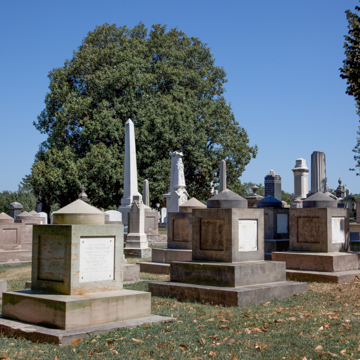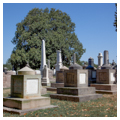L'Enfant intended a large U-shaped building to be placed on this site; by 1793 it was known as the marine hospital site. The articles of subscription of 1807 stipulated that the grounds were to be laid out in three-by-eight–foot sites offered for sale at $2 each. The articles denied burial to “infidels” and persons of color. In 1816 the cemetery was renamed when part of it was set aside for the interment of congressmen. In that year Benjamin Henry Latrobe designed the congressional cenotaphs that continued to be used until 1877, when Arlington National Cemetery became the national burial ground. Starkly abstract in their geometry, they are some of the few examples in this country of the influence of late-eighteenth-century French visionary architecture. Architectural additions include the construction of a superintendent’s house in 1834, a chapel in 1903, and a gatehouse in 1923. The size of the cemetery was likewise expanded to its present 35 acres beginning in the 1840s. Especially influential was the rural cemetery movement that aspired to turn cemeteries into picturesque public parks offering urbanites a pleasant escape from the bustling city.
Notably, the Congressional Cemetery is home to a distinct LGBTQ section that includes the graves of Dr. Franklin E. Kameny and Barbara Gittings, who began the modern gay rights movement in the 1960s, along with that of Leonard Matlovich, who campaigned for gay rights in civilian and military life.
References
“Congressional Cemetery.” National Park Service. Accessed May 9, 2020. https://www.nps.gov/.
“History.” Congressional Cemetery. Accessed May 9, 2020. https://congressionalcemetery.org/.









